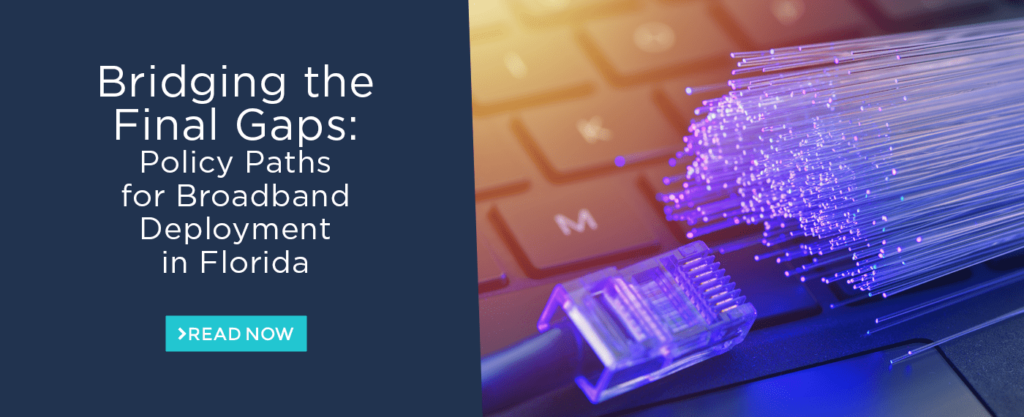By Bartlett Cleland, Adjunct Scholar, The James Madison Institute Executive Director, Innovation Economy Alliance
Click here to read “Bridging the Final Gaps: Policy Paths for Broadband Deployment in Florida”
The broadband industry has invested billions of dollars in covering the country with ever faster, ever more ubiquitous broadband. From one generation of broadband to the next, the country continues to benefit from private industry best serving its customers with new services. Those customers have enjoyed new experiences with health care, education, entertainment, employment and more.
Florida has been amongst the leaders in enabling broadband expansion. The numbers across the country continue to improve as well. But today, perhaps more than ever, more can be done to reach those remaining without access.
National broadband today
In January 2021, the FCC released its annual report on broadband deployment, finding once again that broadband is being deployed to Americans in a reasonable and timely fashion. FCC Chairman Ajit Pai commented, “In just three years, the number of American consumers living in areas without access to fixed broadband at 25/3 Mbps has been nearly cut in half.” That is to say that nearly the entire country has access to speeds of at least 25 megabits per second (Mbps) download and 3 Mbps upload. This is the current and reasonable definition of broadband.
But it is also true that at the end of 2019 more than 14 million, around four percent of the population, U.S. residents across the country lacked access to these speeds, not exclusively but especially in rural areas.
That annual report followed a challenging year for the country in part because of the COVID-19 pandemic, but in trying times the true mettle of people or an industry can be gleaned.
At the beginning of the U.S. coronavirus outbreak, Federal Communications Commission (FCC) Chairman Pai asked broad- band and telephone providers to take the Keep Americans Connected Pledge. Ultimately almost 800 broadband and telephone providers helped millions of Americans stay connected when it was needed most. They pledged not to terminate service to any residential or small business customers because of their inability to pay their bills due to the disruptions caused by the coronavirus pandemic, waived late fees for any residential or small business customers caused by their economic circumstances related to the coronavirus pandemic, and opened Wi-Fi hotspots to any American who needed them.
Chairman Pai also encouraged all providers to expand and improve low-income broadband programs they already had or to adopt low-income programs if they did not have them. In addition, he asked them to relax data cap policies, waive long-distance and overage fees, work with schools and libraries on remote learn- ing opportunities and prioritize the connectivity needs of hospitals and healthcare providers.
Many jumped in, following the extra suggestions and taking them further. For example, Comcast promised to keep Wi-Fi hotspots open through the end of 2020. Verizon automatically enrolled Pledge customers into payment plans. Charter waived a portion of past due balances, and even raised the minimum wage for its workers to $20 an hour, investing in a workforce that can help keep people connected.
This was made possible because of decades of broadband industry investment in people and infrastructure. Despite predictions that the system would buckle, that peaks in use would crash the system, broadband provision grew, and the industry took on more responsibility.
By the beginning of 2021 the understanding of the importance of broadband became apparent even to those who may not have been paying attention previously. Education, healthcare, employment, entertainment and even grocery shopping all became dependent on adequate online access.
To that end, companies, such as Comcast, have continued to lead and to reach even more of those previously without access. The company has announced that they are enhancing and accelerating what has been a long commitment to digital opportunity. This includes increasing speeds to 25 megabits per second (Mbps) (download) and 3 Mbps (upload) for all new as well as existing Internet Essentials customers at no additional cost.












